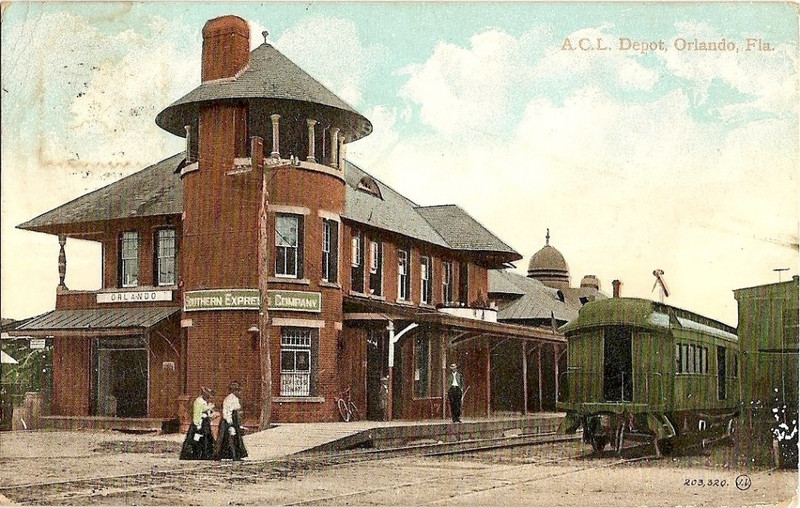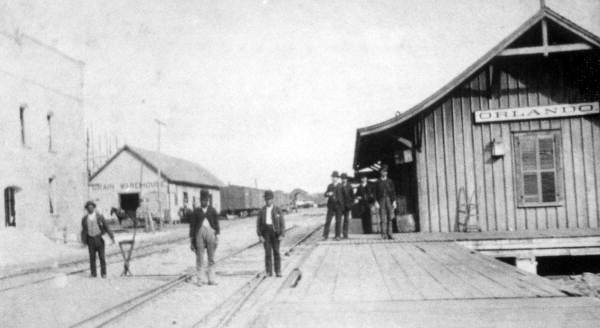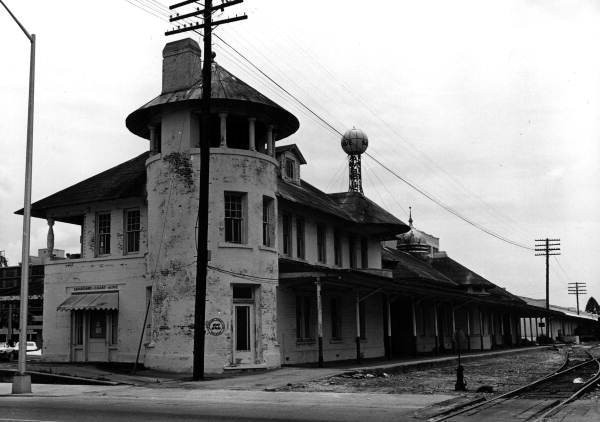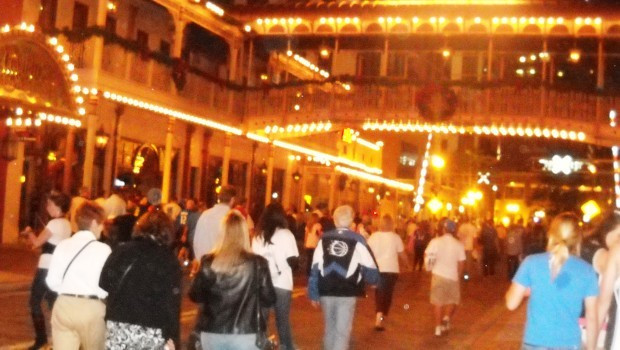Orlando, Florida, now famed for its theme parks, began as a humble cattle trading post. This transformation is vividly reflected in the history of Church Street Station, originally known as the Old Orlando Railroad Depot. Constructed in 1889 by the South Florida Railroad, Church Street Station emerged as a crucial landmark in a town already celebrated for its burgeoning citrus industry and reputation as a health retreat.
 Atlantic Coast Line Depot, late 19th century
Atlantic Coast Line Depot, late 19th century
The story of Church Street Orlando begins even earlier, with the initial, modest wooden station built in 1880. This first depot at 4 Depot Place and West Church Street established a vital link to Sanford. Sanford’s harbor was key, facilitating the transport of goods and people to Jacksonville via steamboat. Adding to the area’s early commercial activity, tickets were sold across from the depot in a warehouse owned by Joseph Bumby, a prominent Orlando businessman and citrus pioneer. The groundbreaking for the South Florida Railroad, championed by Henry Shelton Sanford, took place in Sanford on January 10, 1880. The event was made even more notable by the presence of former President Ulysses S. Grant, a friend of Sanford, who ceremoniously broke ground. The 23-mile railway line became operational on October 1, 1880. The following day, a celebratory train, somewhat overloaded with excited passengers, marked the occasion, even featuring a cannon firing periodically from the last car. Upon reaching Orlando, a grand barbecue awaited, with tables prepared for all attendees, including the African-American workers instrumental in building the railway.
 Built in 1880, the first Orlando Station only connected Orlando and Sanford
Built in 1880, the first Orlando Station only connected Orlando and Sanford
The introduction of the railroad spurred significant growth in Orlando. In just four years following the original station’s construction in 1880, Orlando’s landscape dramatically changed. From a small settlement of about 200 residents and a handful of buildings, the town surged to a population of 1,666 by 1884, boasting 41 commercial establishments. This rapid expansion, coupled with the flourishing citrus industry, necessitated a larger, more permanent station. Consequently, the original wooden depot was replaced in 1889 with the brick structure that still stands today as Church Street Station. The South Florida Railroad itself expanded in 1882, connecting Sanford to Kissimmee. In 1883, Henry Plant acquired the line, integrating it into his Plant System, a vast network of railroads, steamships, and hotels across the Southeast. Later, in 1902, the Plant System was acquired by the Atlantic Coast Line (ACL) Railroad Company, further cementing Church Street Station’s role in a larger transportation network. By the time the new Church Street Station was built, Orlando was already served by the Tavares, Orlando and Atlantic (TO&A) Railroad and the Orlando and Winter Park Railway. Historical records suggest Church Street Station operated as a “Union Station,” indicating that these or other rail services likely utilized the facility. Union Stations were encouraged to streamline rail services within cities, reducing congestion and land use.
 The station in the mid-1970s, after years of neglect, right before the economic boom brought on by entrepreneur Bob Snow
The station in the mid-1970s, after years of neglect, right before the economic boom brought on by entrepreneur Bob Snow
However, as Orlando continued to grow, Church Street Station eventually became inadequate for the increasing volume of passengers and trade. In 1926, the ACL relocated its main depot to what is now the Orlando Health/Amtrak Station. While Church Street Station continued as a ticket office, it faced neglect and by the 1970s was largely abandoned. A new chapter began in 1972 when entrepreneur Bob Snow purchased the station and surrounding buildings, envisioning a downtown Orlando entertainment and shopping hub. This vision led to Church Street Station being listed on the U.S. National Register of Historic Places in 1976, recognizing its historical significance. By 1985, Church Street Station’s entertainment complex was a major economic engine, employing 900 people and attracting 1.7 million visitors annually, ranking as Florida’s fourth-largest tourist attraction.
 In 2007, after a number of renovations, the depot appears almost identical to when it was built in 1889
In 2007, after a number of renovations, the depot appears almost identical to when it was built in 1889
 Church Street Station's shopping and entertainment complex in 2013
Church Street Station's shopping and entertainment complex in 2013
The ownership of Church Street Station changed hands again after Bob Snow sold his interests in the late 1980s, leading to a period of decline in the 1990s. Lou Pearlman acquired a majority stake in 2002, but financial difficulties led to foreclosure in 2007. Developer Cameron Kuhn purchased the complex and reopened it in 2008 with new retail, dining, and nightlife options. In 2014, the arrival of SunRail commuter service, with a platform adjacent to the original station, marked a return to Church Street’s transportation roots. Today, Church Street Orlando stands as a testament to Orlando’s dynamic history, evolving from a railway depot to a vibrant entertainment destination and a continuing link to the city’s past and present.
References
[1] Gregg M. Turner and Seth H. Bramson, The Plant System of Railroads, Steamships and Hotels (Laurys Station, PA: Garrigues House, Publishers).
[2] Donald R. Hensley, Jr., “The South Florida Railroad,” Taplines, accessed November 30, 2015, http://www.taplines.net/southflorida/southflorida.
[3] Steve Herring, “Church Street Station/A.C.L. Depot.” Orlando Retro, accessed November 30, 2015, http://orlandoretro.com/2013/04/07/church-street-station-a-c-l-depot-orlando-fl/.
[4] Turner and Bramson, The Plant System of Railroads, Steamships and Hotels.
[5] Ibid.
[6] E.H. Gore, From Florida Sand to “The City Beautiful”: A Historical Record of Orlando, Florida (Winter Park, Fla.: Orange Press, 1951).
[7] Gregg M. Turner, A Journey into Florida Railroad History (Gainesville: University Press of Florida, 2008), 124-126; Gregg M. Turner and Seth H. Bramson, The Plant System of Railroads, Steamships and Hotels (Laurys Station, PA: Garrigues House, Publishers, 2004).
[8] Michael Mulligan, Railroad Depots of Central Florida (Charleston, SC: Arcadia Publishing, 2008).
[9] Ibid.
[10] “National Register of Historical Places – Florida (FL), Orange County,” National Register of Historic Places, National Park Service, accessed November 30, 2015, http://www.nationalregisterofhistoricplaces.com/FL/Orange/state.html.
[11] Herring, “Church Street Station/A.C.L. Depot.”
[12] Mulligan, Railroad Depots of Central Florida.
